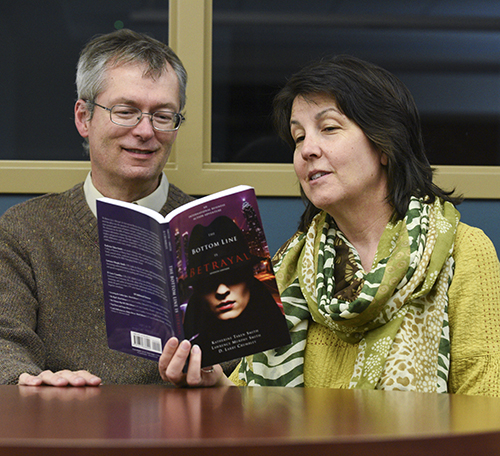
Professors Lawrence Murphy and Katherine Smith look at their novel, “The Bottom Line is Betrayal.”
Betrayal, corporate espionage, mystery and fraud: these words sound more likely to describe the next James Bond movie than assigned reading for class.
But for many marketing and accounting students in the Arthur J. Bauernfeind College of Business, these topics are interwoven into their curriculum along with core business principles in an attempt to make these topics engaging as well as educational.
Lawrence Murphy Smith, professor of business, and Katherine Smith, assistant professor of marketing, are co-authors of the 200-page educational novel, “The Bottom Line is Betrayal”, along with Larry Crumbley, professor of accounting at Louisiana State University.
In the 22 years since “The Bottom Line is Betrayal” was published, it has gone through six subsequent editions. The seventh and latest edition was published this year.
“Our goal is to mix academic technical information into a story that makes technical information come alive,” Lawrence said. “It’s not like reading a regular academic textbook. There’s adventure and mystery as well.”
“The Bottom Line is Betrayal” revolves around an international business professor and litigation consultant hired by the Coca-Cola Company to prevent its downfall through the theft of its secret Coke formula.
The couple said by involving a large corporation such as Coca-Cola, it has allowed for them to touch on the topics of international business, business ethics and look at a variety of positions in companies such as marketing, accounting, finance and management and how they work together.
Lawrence said students in his classes that are assigned to read the novel responded to it much better than a textbook.
“I get a lot of comments from students on teaching evaluations when I’ve used educational novels,” he said. “One student wrote ‘I started reading (the novel) and instead of reading the six chapters I had to for the exam, I couldn’t put it down. That novel was so interesting I finished the whole book in a couple of days.’”
Katherine said she also has noted similar success in her classroom when using the novel as a supplement to traditional textbooks.
“For one thing, they’ll actually read the whole thing,” she said. “Not just skim over the key terms like with a textbook. It actually engages students and brings them into the story, and if you’re actually engaged in what you’re reading, you remember it better.”
But are students learning as well as being entertained by the novel’s topic?
They are, according to a 2013 study by University of Oklahoma professor Jeremy Short, published in Business Communication Quarterly.
In Short’s study, 114 students in a senior-level business course were assigned either a graphic novel, a novel presented in comic-strip format or a textbook for their class covering the same material. Eighty percent of students indicated that they learned and preferred learning from the educational novel and students who read from the educational graphic novel recalled more information verbatim.
Lawrence and Katherine, authors of several textbooks and academic journals, recognized the need for more traditional material in classrooms and said the 200-page novel is only a supplement.
Lawrence said, for now, he is happy with the effectiveness of the novel.
“It’s wonderful to see students engaged in the material you’re trying to teach and that this particular teaching device is having a positive impact,” he said.



























































































